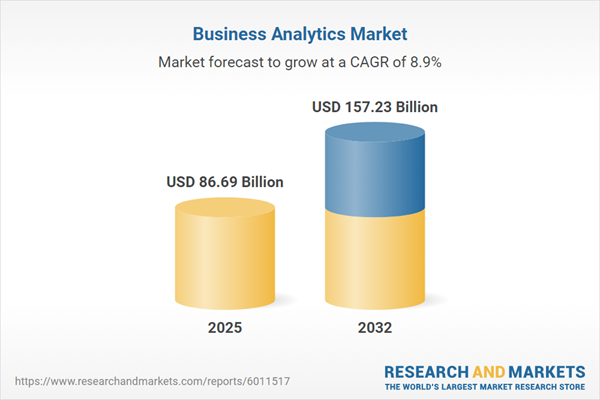Speak directly to the analyst to clarify any post sales queries you may have.
Business analytics is empowering organizations to make informed, strategic decisions by providing timely insights and enhanced clarity amid complex business environments. As enterprises adapt to evolving operational demands, robust analytics platforms are now essential for senior leadership seeking to unlock opportunities, reduce risks, and improve overall performance.
Business Analytics Market Snapshot
The global business analytics market is demonstrating robust growth as analytics solutions become deeply embedded across diverse industry sectors. In 2024, the market stands at USD 79.46 billion, with a projected rise to USD 86.69 billion in 2025. By 2032, long-range forecasts estimate the sector will reach USD 157.23 billion, representing a compound annual growth rate of 8.90% over the forecast period.
The push for digital transformation underpins this trajectory, with organizations investing in tools to automate processes, streamline workflows, and align analytics functions to shifting business objectives. Integrating various data sources, elevating compliance standards, and enhancing operational transparency are enabling enterprises to stay agile as regulatory demands and market contexts evolve. Meanwhile, ongoing technology innovation continues to reshape enterprise approaches to leveraging data for competitive advancement.Scope & Segmentation of the Business Analytics Market
- Service Types: Consulting services offer end-to-end guidance, from designing analytics initiatives to execution and optimization. Software solutions transform raw data into valuable intelligence, supporting executive reporting and sophisticated data visualizations that drive decision-making.
- Deployment Models: Cloud deployments—including public, private, and hybrid—deliver flexibility and scalability, while on-premises options persist for organizations prioritizing regulatory compliance and legacy infrastructure compatibility.
- End Users: Key sectors utilizing business analytics include banking and financial services, government, healthcare, information technology, telecommunications, automotive, electronics, retail, and e-commerce. Each sector applies analytics for customized intelligence, operational improvement, and stronger customer engagement.
- Applications: Major uses encompass interactive dashboards, visual analytics, and predictive modeling, equipping enterprises with scenario planning and enhanced process efficiency.
- Regional Reach: The market serves the Americas, Europe, Middle East, Africa, and Asia-Pacific, with countries like the UK, Germany, UAE, South Africa, Nigeria, China, India, Japan, Australia, South Korea, and Singapore reflecting diverse regulatory requirements and investment trends.
- Reviewed Companies: Leading vendors—including Microsoft Corporation, SAP SE, Oracle Corporation, Salesforce, IBM, SAS Institute, QlikTech, TIBCO, MicroStrategy, and Google LLC—drive market capabilities, foster global collaborations, and expand solution scope for clients.
Key Takeaways for Senior Decision-Makers
- AI and machine learning integration within analytics platforms accelerates insight delivery, enabling management to quickly respond to changes and uncover operational efficiencies.
- Stricter privacy and compliance mandates are intensifying the demand for robust data governance, pushing enterprises to reinforce transparency and establish effective analytics control systems.
- Cloud-based analytics facilitate cross-functional collaboration among dispersed teams, allowing organizations to adapt workflows rapidly as business or regulatory needs shift.
- Industry-specific analytics solutions are encouraging technology partnerships and supporting digital transformation in sectors with complex, niche requirements.
- Ongoing workforce skill development initiatives are crucial for cultivating a resilient, data-driven organizational culture that can navigate regulatory and economic uncertainties.
Tariff Impact on Analytics Operations
With new U.S. tariffs anticipated in 2025, organizations are reassessing their supply chain strategies surrounding analytics infrastructure. Enterprises are expanding their network of vendors and forging strategic partnerships to maintain operational continuity. Analytics solution providers are increasingly leveraging remote service delivery, ensuring that digital projects move forward efficiently and helping clients mitigate cost impacts as logistics landscapes shift.
Methodology & Data Sources
The research combines comprehensive secondary data review, targeted executive interviews, and insights from experienced market practitioners. Triangulation and cross-checking by multiple sources confirm the findings' accuracy and provide actionable perspectives tailored to decision-maker needs.
Why This Report Matters for the Business Analytics Market
- Offers objective benchmarks, enabling organizations to proactively manage compliance and address complex market challenges.
- Informs technology investment and workforce strategy decisions, supporting effective analytics implementation and robust governance frameworks.
- Delivers practical intelligence to enhance enterprise decision-making and foster successful results in specialized industry environments.
Conclusion
As business analytics technology evolves alongside regulatory frameworks, organizations deploying advanced analytics remain better equipped to sustain adaptability and achieve ongoing operational performance in changing global conditions.
Additional Product Information:
- Purchase of this report includes 1 year online access with quarterly updates.
- This report can be updated on request. Please contact our Customer Experience team using the Ask a Question widget on our website.
Table of Contents
3. Executive Summary
4. Market Overview
7. Cumulative Impact of Artificial Intelligence 2025
Companies Mentioned
The companies profiled in this Business Analytics market report include:- Microsoft Corporation
- SAP SE
- Oracle Corporation
- Salesforce, Inc.
- International Business Machines Corporation
- SAS Institute, Inc.
- QlikTech International AB
- TIBCO Software Inc.
- MicroStrategy Incorporated
- Google LLC
Table Information
| Report Attribute | Details |
|---|---|
| No. of Pages | 188 |
| Published | October 2025 |
| Forecast Period | 2025 - 2032 |
| Estimated Market Value ( USD | $ 86.69 Billion |
| Forecasted Market Value ( USD | $ 157.23 Billion |
| Compound Annual Growth Rate | 8.9% |
| Regions Covered | Global |
| No. of Companies Mentioned | 11 |









